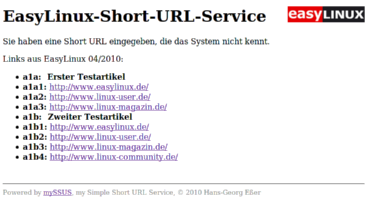![]()
Blaue Links: intern
|
mySSUSmy Simple Short URL Service Navigation: description | reasons | setup | screenshot | download | limitations | license What is it? FeaturesmySSUS is my Simple Short URL Service and it has the following features:
Reasons for mySSUS; what the "database" looks likeShort URLs can be managed in a hierarchical way. The tool came into existence because I needed a short URL service for the magazine I work for (EasyLinux). This was the task: In
I found no such tool, now there is one (mySSUS). This is a sample file: a1 EasyLinux 04/2010 a1a Erster Testartikel a1a1 http://www.easylinux.de/ a1a2 http://www.linux-user.de/ a1a3 http://www.linux-magazin.de/ a1b Zweiter Testartikel a1b1 http://www.easylinux.de/ a1b2 http://www.linux-user.de/ a1b3 http://www.linux-magazin.de/ a1b4 http://www.linux-community.de/Empty lines will be ignored, but you can enter them in order to make the data file readable. Separation of short and long URL happens with \t (tab) in this case, you can reconfigure mySSUS to use something different. However the separator should be something that will not appear anywhere else. If it does appear elsewhere, the tool breaks (it is "simple", as promised). The short URLs have a syntax which represents the hierarchy mentioned above. In the example URL a1b4 the parts mean:
The file contains header entries (a1, a1a, a1b in the example). The first one (a1) is required for the file, it names the issue. The other ones (a1a, a1b) name articles, and they will be shown in some situations if available. SetupIn order to use mySSUS, you need to do three things:
Also you will have to provide at least one data file to make any use of the software, but it will work without one, just displaying the standard texts. ScreenshotThis is what it will look like. (The sample images shows what you see when using a short URL that cannot be found but seems to belong to an issue that is known. If you enter a correct short URL you will be redirected after two seconds.) DownloadmySSUS comes as a tar.gz archive containing index.py, a sample a1.data file and some documentation. Versions:
LimitationsThe code is simple. It hardly does any error condition checking. It will not crash when it cannot open a data file, but that is all you get. Documentation within the code is in German language. License
mySSUS 0.1: my Simple Short URL Service This program is free software: you can redistribute it and/or modify it under the terms of the GNU General Public License as published by the Free Software Foundation, either version 3 of the License, or (at your option) any later version. This program is distributed in the hope that it will be useful, but WITHOUT ANY WARRANTY; without even the implied warranty of MERCHANTABILITY or FITNESS FOR A PARTICULAR PURPOSE. See the GNU General Public License for more details. You should have received a copy of the GNU General Public License along with this program. If not, see http://www.gnu.org/licenses/. |
Copyright © 1997-2025 Hans-Georg Eßer; Server: Debian Linux, Apache Web Server, letzte Änderung: Monday, 22-Jul-2013 22:14:47 CEST
Theme:
